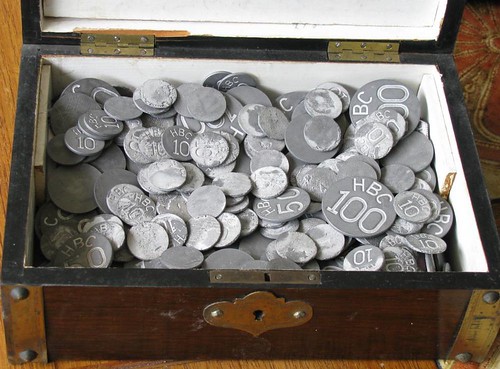
PREV ARTICLE
NEXT ARTICLE
FULL ISSUE
PREV FULL ISSUE
THE SOUTH DAKOTA HUDSON'S BAY COMPANY TOKEN HOARD
Greg Ingram of Calgary, AB Canada published an article about a find of Hudson's Bay Company tokens in the January 2010 issue of the Alaska Token Collector (Dick Hanscom, Editor). With permission, I'm including some excerpts below.
-Editor

This hoard came out of South Dakota, the seller indicating he had had them for many years. I have dubbed them the "South Dakota Hoard." Even though the Hudson Bay Company did have posts in the Dakotas in the very early years, they were no longer operating in the 1940s, so it is highly unlikely they were used in that area. This was a large lot with many pieces badly corroded. Surviving this corrosion was (25) 100 Cent, (69) 50 Cent and (27) 10 Cent. There were (125) badly corroded 10 cent pieces. Variances in some of the 50 Cent and 10 Cent pieces have been noticed and will be discussed. They look a lot like the 1946 aluminum issue with 5, 10, 25, 50 and 100 cent denomination pieces (there were no 5 or 25 cent pieces in the hoard). But comparing them to the known aluminum set from 1946, they are quite different in size and color. They are quite a bit smaller in diameter, and they are darker in color. The lettering also appears to have been painted white. I did my own comparison analysis from samples sent to me to the known tokens in this series. A very careful and extensive analysis was performed on these tokens in an effort to determine their authenticity, or conversely, their counterfeit nature! A detailed report was provided to us... Are these modern day reproductions and hence counterfeits? Since the known set of tokens in the 1946 series can fetch $200-$300 a set, the incentive to counterfeit is there. However, a modern day counterfeiter would make these pieces look more like the original series. Clearly this new discovery is quite different from the known series! A modern day counterfeiter would not have allowed so many of the 10 cent pieces to become so corroded. These tokens would have been introduced to the collector community a few at a time if counterfeiting was their purpose. These were sold in one lot, something a counterfeiter would not do. For these reasons and the argument for contemporary production posed next, we can clearly discount these as modern day counterfeits. Are these a contemporary production of HBC tokens? This appears to be the case. HBC tokens were produced for internal use only, that is, between the trader and the Hudson Bay Company and had only value in trade at the store. This means they had no value outside of the HBC, other than to collectors of HBC tokens. Greg Ingram adds: The article will be published shortly in CATC and C-4 Token collectors groups in Canada and the US, and I believe The Numismatist will be running it as well. It was published in Canadian Coins News as well over the last few months.
It's always an interesting and important chore to determine the authenticity of hoard pieces. It's a cat and mouse game between forger and collector. Time will tell what the collector community feels about these. Many thanks to Greg and Dick for making the image and article text available for readers of The E-Sylum.
-Editor
Wayne Homren, Editor The Numismatic Bibliomania Society is a non-profit organization promoting numismatic literature. See our web site at coinbooks.org. To submit items for publication in The E-Sylum, write to the Editor at this address: whomren@gmail.com To subscribe go to: https://my.binhost.com/lists/listinfo/esylum All Rights Reserved. NBS Home Page Contact the NBS webmaster 
|